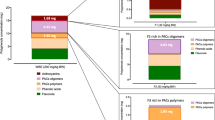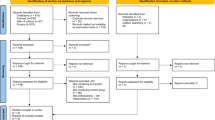Abstract
Objective:
The aim of the present study is to investigate the effect of antioxidant polyphenol-rich pomegranate juice (PJ) supplementation for 5 weeks on patients with stable chronic obstructive pulmonary disease (COPD), since the oxidative stress plays a major role in the evolution and pathophysiology of COPD.
Design:
A randomized, double-blind, placebo-controlled trial was conducted.
Subjects:
A total of 30 patients with stable COPD were randomly distributed in two groups (15 patients each).
Interventions:
Both groups consumed either 400 ml PJ daily or matched placebo (synthetic orange-flavoured drink) for 5 weeks. Trolox Equivalent Antioxidant Capacity (TEAC) of PJ, blood parameters (14 haematological and 18 serobiochemical), respiratory function variables, bioavailability of PJ polyphenols (plasma and urine) and urinary isoprostane (8-iso-PGF2α) were evaluated.
Results:
The daily dose of PJ (containing 2.66 g polyphenols) provided 4 mmol/l TEAC. None of the polyphenols present in PJ were detected in plasma or in urine of volunteers. The most abundant PJ polyphenols, ellagitannins, were metabolized by the colonic microflora of COPD patients to yield two major metabolites in both plasma and urine (dibenzopyranone derivatives) with no TEAC. No differences were found (P>0.05) between PJ and placebo groups for any of the parameters evaluated (serobiochemical and haematological), urinary 8-iso-PGF2α, respiratory function variables and clinical symptoms of COPD patients.
Conclusions:
Our results suggest that PJ supplementation adds no benefit to the current standard therapy in patients with stable COPD. The high TEAC of PJ cannot be extrapolated in vivo probably due to the metabolism of its polyphenols by the colonic microflora. The understanding of the different bioavailability of dietary polyphenols is critical before claiming any antioxidant-related health benefit.
Sponsorship:
‘Fundación Séneca’ (Murcia, Spain), Project PB/18/FS/02 and Spanish CICYT, Project AGL2003-02195.
This is a preview of subscription content, access via your institution
Access options
Subscribe to this journal
Receive 12 print issues and online access
$259.00 per year
only $21.58 per issue
Buy this article
- Purchase on Springer Link
- Instant access to full article PDF
Prices may be subject to local taxes which are calculated during checkout

Similar content being viewed by others
References
American Thoracic Society (1994). Standardization of spirometry – 1994 update. AmJ Respir Crit Care Med 152, 1107–1136.
Arai Y, Watanabe S, Kimira M, Simio K, Mochizuki R, Kinae N (2001). Dietary intakes of flavonols, flavones and isoflavones by Japanese women and the inverse correlation between quercetin intake and plasma LDL cholesterol. J Nutr 130, 2378–2383.
Aviram M, Dornfeld L (2001). Pomegranate juice consumption inhibits serum angiotensin converting enzyme activity and reduces systolic blood pressure. Atherosclerosis 158, 195–198.
Aviram M, Dornfeld L, Rosenblat M, Volkova N, Kaplan M, Coleman R et al. (2000). Pomegranate juice consumption reduces oxidative stress, atherogenic modifications to LDL, and platelet aggregation: studies in humans and in atherosclerotic apolipoprotein E-deficient mice. Am J Clin Nutr 71, 1062–1176.
Barnes PJ, Hansel TT (2004). Prospects for new drugs for chronic obstructive pulmonary disease. Lancet 364, 985–996.
Cerdá B, Espín JC, Parra S, Martínez P, Tomás-Barberán FA (2004). The potent in vitro antioxidant ellagitannins from pomegranate juice are metabolized into bioavailable but poor antioxidant hydroxy-6H-dibenzopyran-6-one derivatives by the colonic microflora of healthy humans. Eur J Nutr 43, 205–220.
Cerdá B, Llorach R, Cerón JJ, Espín JC, Tomás-Barberán FA (2003). Evaluation of the bioavailability and metabolism in the rat of punicalagin, and antioxidant polyphenol from pomegranate juice. Eur J Nutr 42, 18–28.
Cerdá B, Tomás-Barberán FA, Espín JC (2005). Metabolism of antioxidant and chemopreventive ellagitannins from strawberries, raspberries, walnuts and oak-aged wine in humans: identification of biomarkers and individual variability. J Agric Food Chem 53, 227–235.
Culpitt SV, Rogers DF, Fenwick PS, Shah P, De Matos C, Russell RE et al. (2003). Inhibition by red wine extract, resveratrol, of cytokine release by alveolar macrophages in COPD. Thorax 58, 942–946.
Devereux G, Seaton A (2001). Why don't we give chest patients dietary advice? Thorax 56S, 15–22.
Engler MB, Engler MM, Chen CY, Malloy MJ, Browne A, Chiu EY et al. (2004). Flavonoid-rich dark chocolate improves endothelial function and increases plasma epicatechin concentrations in healthy adults. J Am Coll Nutr 23, 197–204.
Espín JC, Wichers HJ (2000). Study of the oxidation of resveratrol catalyzed by polyphenol oxidase. Effect of polyphenol oxidase on the antiradical capacity of resveratrol. J Food Biochem 24, 225–250.
Gil MI, Tomás-Barberán FA, Hess-Pierce B, Holcroft DM, Kader AA (2000). Antioxidant activity of pomegranate juice and its relationship with phenolic composition and processing. J Agric Food Chem 48, 4581–4589.
GOLD (Global Initiative for Chronic Obstructive Lung Disease). Global strategy for the diagnosis, management, and prevention of chronic obstructive pulmonary disease. http://www.goldcopd.com.
Halliwell B, Whiteman M (2004). Measuring reactive species and oxidative damage in vivo and in cell culture: how should you do it and what do the results mean? Br J Pharmacol 142, 231–255.
Kaplan M, Hayek T, Raz A, Coleman R, Dornfeld L, Vaya J et al. (2001). Pomegranate juice supplementation to atherosclerotic mice reduces macrophage lipid peroxidation, cellular cholesterol accumulation and development of atherosclerosis. J Nutr 131, 2082–2089.
Langen RC, Korn SH, Wouters EF (2003). ROS in the local and systemic pathogenesis of COPD. Free Radic Biol Med 35, 226–235.
Limer JL, Speirs V (2004). Phyto-oestrogens and breast cancer chemoprevention. Breast Cancer Res 6, 119–127.
MacNee W (2000). Oxidants/antioxidants and COPD. Chest 117S, 303–317.
Madihassan S (1984). Outline of the beginnings of alchemy and its antecedents. Am J Chin Med 12, 32–42.
Molfino NA (2004). Genetics of COPD. Chest 125, 1929–1940.
Murray CJ, Lopez AD (1997). Alternative projections of mortality and disability by cause 1990–2020: Global Burden of Disease Study. Lancet 349, 1498–1504.
Noda Y, Kaneyuki T, Mori A, Packer L (2002). Antioxidant activities of pomegranate fruit extract and its anthocyanidins: delphinidin, cyanidin, and pelargonidin. J Agric Food Chem 50, 166–171.
O'Reilly JD, Mallet AI, McAnlis GT, Young IS, Halliwell B, Sanders TA et al. (2001). Consumption of flavonoids in onions and black tea: lack of effect on F2-isoprostanes and autoantibodies to oxidized LDL in healthy humans. Am J Clin Nutr 73, 1040–1044.
Öner-Iyidogãn Y, Koçak H, Gürdöl F, Koçak T, Erol B (2004). Urine 8-isoprostane F2 α concentrations in patients with neurogenic bladder due to spinal cord injury. Clin Chim Acta 339, 43–47.
Perez-Padilla R, Regalado J, Vedal S, Pare P, Chapela R, Sansores R et al. (1996). Exposure to biomass smoke and chronic airway disease in Mexican women. A case–control study. Am J Respir Crit Care Med 154, 701–706.
Poole PJ, Black PN (2001). Oral mucolytic drugs for exacerbations of chronic obstructive pulmonary disease: systematic review. Br Med J 322, 1271–1274.
Praticò D (1999). F2-isoprostanes: sensitive and specific non-invasive indices of lipid peroxidation in vivo. Atherosclerosis 147, 1–10.
Praticò D, Basili S, Vieri M, Cordova C, Violi F, Fitzgerald GA (1998). Chronic obstructive pulmonary disease is associated with an increase in urinary levels of isoprostane F2 α-III, an index of oxidant stress. Am J Respir Crit Care Med 158, 1709–1714.
Proudfott J, Barden A, Mori TA, Burke V, Croft KD, Beilin LJ et al. (1999). Measurement of urinary F2-isoprostanes as markers of in vivo lipid peroxidation – a comparison of enzyme immunoassay with gas chromatography/mass spectrometry. Anal Biochem 272, 209–215.
Rahman I, Morrison D, Donaldson K, MacNee W (1996). Systemic oxidative stress in asthma, COPD, and smokers. Am J Respir Crit Care Med 154, 1055–1060.
Repine JE, Bast A, Lankhorst I (1997). Oxidative stress in chronic obstructive pulmonary disease. Oxidative Stress Study Group. Am J Respir Crit Care Med 156, 341–357.
Rice-Evans CA, Miller JN (1994). Total antioxidant status in plasma and body fluids. Meth Enzymol 234, 279–293.
Santus P, Sola A, Carlucci P, Fumagalli F, Di-Gennaro A, Mondoni M et al. (2005). Lipid peroxidation and 5-lipoxigenase activity in chronic obstructive pulmonary disease. Am J Respir Crit Care Med 171, 1–6.
Singh RP, Chidambara Murthy KN, Jayaprakasha GK (2002). Studies on the antioxidant activity of pomegranate (Punica granatum) peel and seed extracts using in vitro models. J Agric Food Chem 50, 81–86.
Tabak C, Arts IC, Smit HA, Heederik D, Kromhout D (2001). Chronic obstructive pulmonary disease and intake of catechins, flavonols, and flavones: the MORGEN Study. Am J Respir Crit Care Med 164, 61–64.
Vogelzang PFJ, van der Gulden JW, Folgering H, Kolk JJ, Heederik D, Preller L et al. (1998). Endotoxin exposure as a major determinant of lung function decline in pig farmers. Am J Respir Crit Care Med 157, 15–18.
Waddington E, Puddey IB, Croft KD (2004). Red wine polyphenolic compounds inhibit atherosclerosis in apolipoprotein E-deficient mice independently of effects on lipid peroxidation. Am J Clin Nutr 79, 54–61.
Watson L, Margetts B, Howarth P, Dorward M, Thompson R, Little P (2002). The association between diet and chronic obstructive pulmonary disease in subjects selected from general practice. Eur Respir J 20, 313–318.
WHO (2002). World Health Report 2002. http://www.who.int/whr/2002.
Wiseman H, O'Reilly JD, Adlercreutz H, Mallet AI, Bowey EA, Rowland IR et al. (2000). Isoflavone phytoestrogens consumed in soy decrease F2-isoprostane concentrations and increase resistance of low-density lipoprotein to oxidation in humans. Am J Clin Nutr 72, 395–400.
Wiswedel I, Hirsch D, Kropf S, Gruening M, Pfister E, Schewe T et al. (2004). Flavanol-rich cocoa drink lowers plasma F2-isoprostane concentrations in humans. Free Radic Biol Med 37, 411–421.
Wonnacott TH, Wonnacott RJ (1990). Introductory Statistics. John Wiley & Sons: New York.
Yang CS, Landau JM, Huang MT, Newmark HL (2001). Inhibition of carcinogenesis by dietary polyphenolic compounds. Annu Rev Nutr 21, 381–406.
Acknowledgements
BC has a fellowship from the Spanish ‘Consejo Superior de Investigaciones Científicas’ (CSIC) and ESF (I3P Program). We are grateful to Ms Ana María Hita, Ms Mari Carmen Garay and Ms María José Salmerón from the ‘Virgen de La Arrixaca University Hospital’ (Murcia, Spain) for their assistance in some parts of this study.
Author information
Authors and Affiliations
Corresponding author
Additional information
Guarantor: JC Espín.
Contributors: BC: Preparation of juice; lipidogram; processing of blood and urine samples for determining polyphenols or derived metabolites; ABTS assay; ‘link’ between CEBAS-CSIC (research centre) and Virgen de La Arrixaca University Hospital. CS: Determination of respiratory function variables and physical examination of COPD patients. MDA: Collection of blood samples; isoprostane assay. PM: Processing of blood samples for determining serobiochemical and haematological parameters. FSG: Coordination and recruitment of COPD patients. FTB: Analysis of polyphenols in pomegranate juice and in vivo-generated metabolites in plasma and urine. JCE: Design of the experiment; writing of the manuscript; coordination of the trial.
Rights and permissions
About this article
Cite this article
Cerdá, B., Soto, C., Albaladejo, M. et al. Pomegranate juice supplementation in chronic obstructive pulmonary disease: a 5-week randomized, double-blind, placebo-controlled trial. Eur J Clin Nutr 60, 245–253 (2006). https://doi.org/10.1038/sj.ejcn.1602309
Received:
Revised:
Accepted:
Published:
Issue Date:
DOI: https://doi.org/10.1038/sj.ejcn.1602309
Keywords
This article is cited by
-
Pomegranate variety and pomegranate plant part, relevance from bioactive point of view: a review
Bioresources and Bioprocessing (2021)
-
100% Fruit juice intake and cardiovascular risk: a systematic review and meta-analysis of prospective and randomised controlled studies
European Journal of Nutrition (2021)
-
Comparative studies of urolithins and their phase II metabolites on macrophage and neutrophil functions
European Journal of Nutrition (2021)
-
Effects of chronic consumption of specific fruit (berries, citrus and cherries) on CVD risk factors: a systematic review and meta-analysis of randomised controlled trials
European Journal of Nutrition (2021)
-
Lack of efficacy of pomegranate supplementation for glucose management, insulin levels and sensitivity: evidence from a systematic review and meta-analysis
Nutrition Journal (2017)



